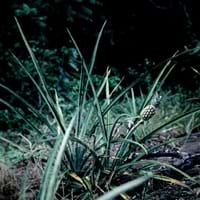Life Span
Annual and Perennial
Biennial
Type
Bulb or Corm or Tuber
Tender Perennial
Origin
Central America, South America
South America, Brazil
Types
Vine, Flowering plant
Not Available
Number of Varieties
Not Available
Habitat
All sorts of environments, Along Railroads, Banks, Moist Ditches, Roadsides, rocky banks of streams
Tropical regions
USDA Hardiness Zone
10-13
10-15
Sunset Zone
21,22
H1, H2, 24
Habit
Vining/Climbing
Rosette/Stemless
Minimum Width
Not Available
Flower Color
Purple, Rose
Purple, Blue Violet
Flower Color Modifier
Bicolor
Not Available
Fruit Color
Not Available
Gold, Magenta, Rose
Leaf Color in Spring
Purple, Dark Green, Black
Green, Gray Green
Leaf Color in Summer
Light Green
Green, Gray Green
Leaf Color in Fall
Several shades of Green
Green, Gray Green
Leaf Color in Winter
Light Green
Gray Green
Leaf Shape
Acicular
Arrowhead
Plant Season
Spring, Summer, Fall, Winter
Spring, Summer, Fall, Winter
Sunlight
Full Sun, Partial Sun
Full Sun, Partial Sun
Growth Rate
Very Fast
Medium
Type of Soil
Clay, Loam, Sand
Loam, Sand
The pH of Soil
Acidic, Neutral, Alkaline
Acidic, Neutral
Soil Drainage
Well drained
Well drained
Bloom Time
Late Spring, Early Summer, Summer, Late Summer, Early Fall, Fall, Late Fall
Spring, Late Spring
Tolerances
Drought
Drought
Where to Plant?
Container, Ground
Container, Ground, Pot
How to Plant?
Cuttings, Leaf Cutting, Tuber propagation
Divison
Plant Maintenance
Medium
Medium
Watering Requirements
Keep the Soil well drained, Needs very little water
Average Water Needs, Needs less watering, Requires consistently moist soil, Water occasionally
In Summer
Lots of watering
Lots of watering
In Spring
Moderate
Moderate
In Winter
Average Water
Average Water
Soil pH
Acidic, Neutral, Alkaline
Acidic, Neutral
Soil Type
Clay, Loam, Sand
Loam, Sand
Soil Drainage Capacity
Well drained
Well drained
Sun Exposure
Full Sun, Partial Sun
Full Sun, Partial Sun
Pruning
Remove damaged leaves, Remove dead branches, Remove dead leaves
Remove damaged leaves, Remove dead branches, Remove dead leaves
Fertilizers
All-Purpose Liquid Fertilizer
All-Purpose Liquid Fertilizer
Pests and Diseases
Red blotch
Scale
Plant Tolerance
Drought
Drought
Flowers
Showy
Insignificant
Flower Petal Number
Single
Single
Foliage Texture
Coarse
Coarse
Foliage Sheen
Matte
Matte
Attracts
Aphids, Beetles, Cutworms, Insects, Mites, Whiteflies
Beetles, Mealybugs, Mites
Allergy
Abdominal pain, allergic reaction, Nausea, Skin rash, Twitching of face
Dermititis, Itchiness
Aesthetic Uses
Not Used For Aesthetic Purpose
Showy Purposes
Beauty Benefits
Not Available
Acne, For treating wrinkles, Good for skin, Improve skin tone, Skin irritation, Skin Problems, Stops hair loss
Environmental Uses
Air purification
Air purification
Medicinal Uses
Cures constipation, Fiber, Low calories, lowering blood pressure, Potassium, ß-carotene, Vitamin A, Vitamin C
Aging, Asthma, Atherosclerosis, Cancer, Digestion problems, Fertility, Heart problems, High blood pressure, Immunity, Indigestion, Inflammation, Itching, Skin irritation, Swelling
Part of Plant Used
Leaves, Root, Shoots, Stem, Tuber
Fruits
Other Uses
Starch, Used As Food, Used as Ornamental plant
Cosmetics, Used As Food, Used as Ornamental plant, Used for its medicinal properties
Used As Indoor Plant
Sometimes
Yes
Used As Outdoor Plant
Yes
Yes
Garden Design
Container, Edible, Groundcover, Hanging Basket, Herb / Vegetable, Mixed Border, Rock Garden / Wall, Vine
Container, Houseplant, Mixed Border, Tropical
Botanical Name
IPOMOEA batatas 'Blackie'
ANANAS nanus
Common Name
Blackie Sweet Potato Vine, Sweet Potato Vine
Dwarf Pineapple, Piñita, Pink Pineapple
In Hindi
शकरकन्द
Pink Pineapple
In German
Süßkartoffel
Pink Pineapple
In French
Patate douce
Pink Pineapple
In Spanish
Ipomoea batatas
Pink Pineapple
In Greek
Sweet potato
Pink Pineapple
In Portuguese
Batata-doce
Ananás-de-raposa
In Polish
Wilec ziemniaczany
Pink Pineapple
In Latin
Ipomoea batatas
Pink Pineapple
Phylum
Tracheophyta
Not Available
Class
Magnoliopsida
Not Available
Family
Convolvulaceae
Bromeliaceae
Clade
Angiosperms, Asterids, Eudicots
Angiosperms, Commelinids, Monocots
Tribe
Not Available
Not Available
Subfamily
Not Available
Bromelioideae
Number of Species
Not Available
Not Available
Season and Care of Sweet Potato Vine and Pink Pineapple
Season and care of Sweet Potato Vine and Pink Pineapple is important to know. While considering everything about Sweet Potato Vine and Pink Pineapple Care, growing season is an essential factor. Sweet Potato Vine season is Spring, Summer, Fall and Winter and Pink Pineapple season is Spring, Summer, Fall and Winter. The type of soil for Sweet Potato Vine is Clay, Loam, Sand and for Pink Pineapple is Loam, Sand while the PH of soil for Sweet Potato Vine is Acidic, Neutral, Alkaline and for Pink Pineapple is Acidic, Neutral.
Sweet Potato Vine and Pink Pineapple Physical Information
Sweet Potato Vine and Pink Pineapple physical information is very important for comparison. Sweet Potato Vine height is 15.00 cm and width Not Available whereas Pink Pineapple height is 45.70 cm and width 50.80 cm. The color specification of Sweet Potato Vine and Pink Pineapple are as follows:
Sweet Potato Vine flower color: Purple and Rose
Sweet Potato Vine leaf color: Purple, Dark Green and Black
Pink Pineapple flower color: Purple and Blue Violet
- Pink Pineapple leaf color: Green and Gray Green
Care of Sweet Potato Vine and Pink Pineapple
Care of Sweet Potato Vine and Pink Pineapple include pruning, fertilizers, watering etc. Sweet Potato Vine pruning is done Remove damaged leaves, Remove dead branches and Remove dead leaves and Pink Pineapple pruning is done Remove damaged leaves, Remove dead branches and Remove dead leaves. In summer Sweet Potato Vine needs Lots of watering and in winter, it needs Average Water. Whereas, in summer Pink Pineapple needs Lots of watering and in winter, it needs Average Water.





